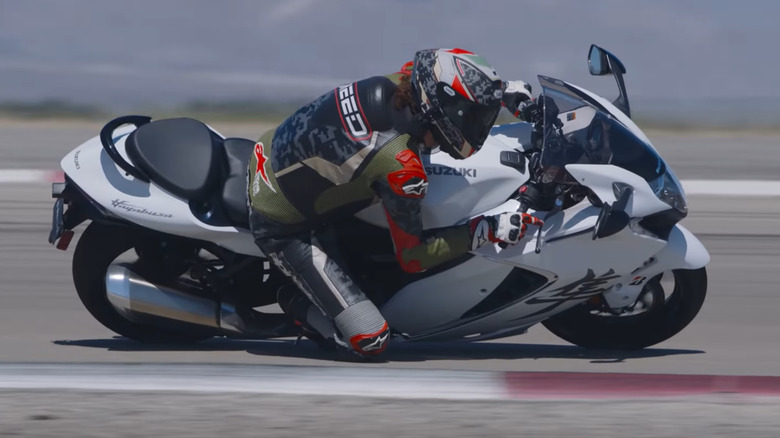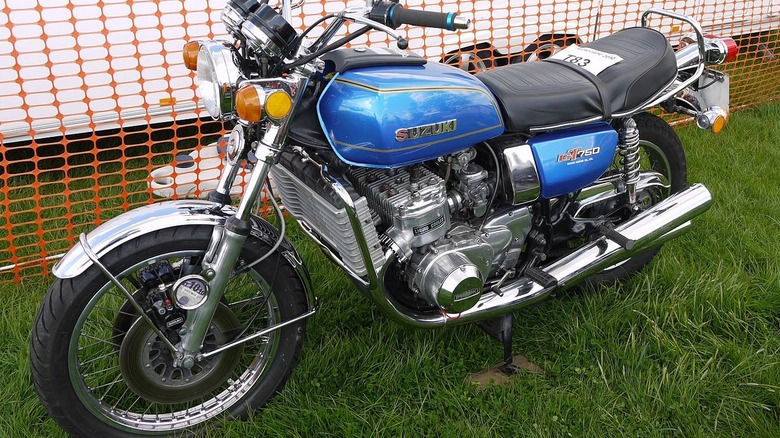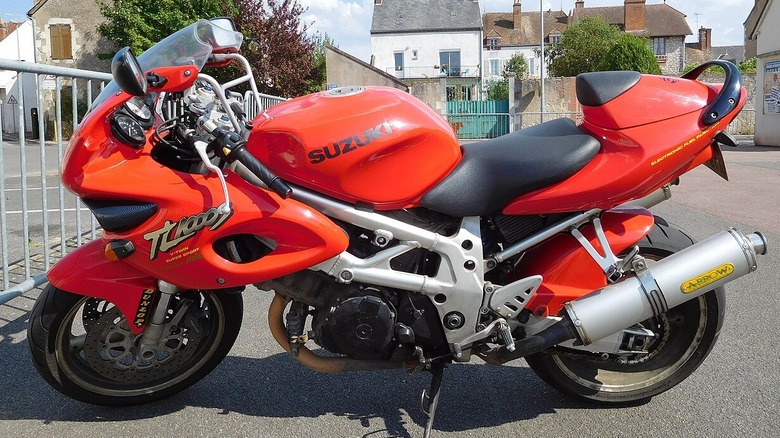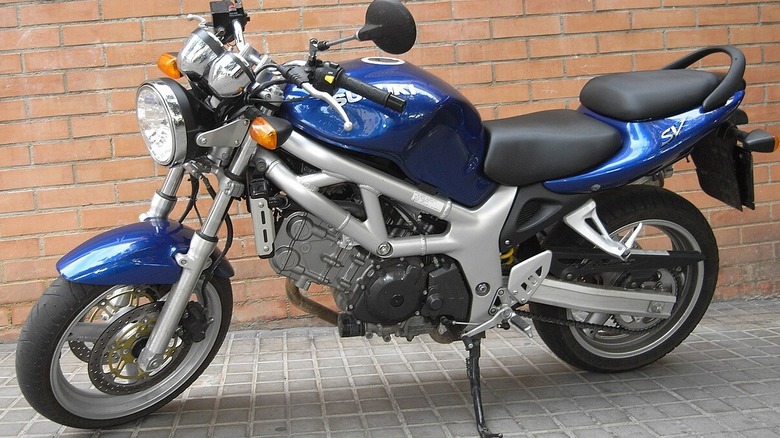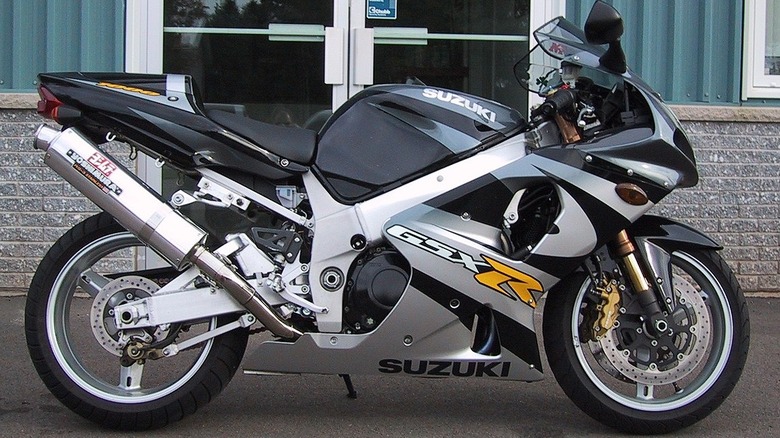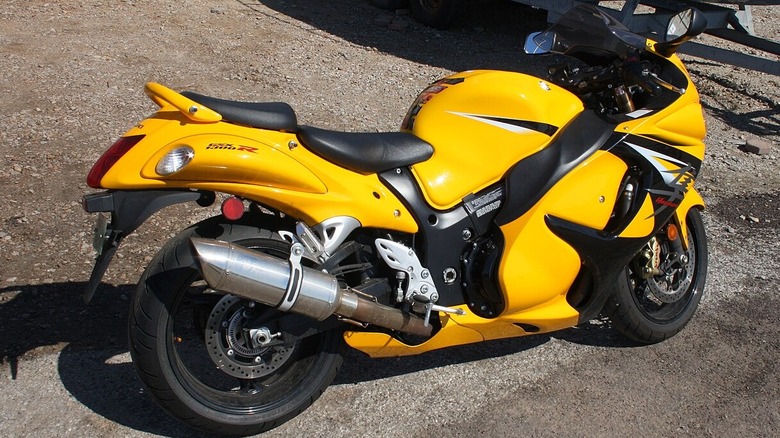5 Of The Best-Sounding Suzuki Motorcycles Ever Built
The auditory experience of riding a motorcycle is deeply intertwined in motorcycle culture. It could be part of the reason why electric bikes haven't taken off among two-wheeler enthusiasts, unlike cars. While many non-bike people might feel motorcycle sounds are just a byproduct, the truth is that most motorcycle owners will deliberately pick a bike based on its sound or even go a step further and add an aftermarket exhaust to tweak the overall acoustic experience to their liking.
Part of American motorcycle culture meetups consists of bikers converging at their favorite restaurant or coffee stand and sweeping through the streets in formation. While most of the thrill is experienced while testing the limits of their machines and hitting high RPMS through open country roads, it's hard to ignore the beehive-like auditory effect produced as they choke the handlebars chasing their adrenaline high. However, annoying it may feel to non-participants, the loud buzzing or humming is a key element that contributes to the overall experience and identity of riders.
Suzuki ranks among the top five motorcycle makers, not just for developing the best-performing bikes, but for being one of the most affordable and reliable brands. Its inline-fours are particularly popular among enthusiasts thanks to their unique and distinctive exhaust notes. For the purpose of this list, we've put together some of the best-sounding Suzuki motorcycles produced, comparing their auditory experience and feel based on engine type, exhaust note complexity, and, of course, the firing order signature.
Suzuki GT750 Kettle
The Suzuki GT750 is popularly known among enthusiasts as "Kettle" or "water Buffalo." It is quite an iconic motorcycle in Japanese history, and was the answer to Kawasaki's 750 triple. For starters, the GT750 was the first bike in Japanese history to use water-cooling (hence its nicknames) and was also the swansong for Suzuki two-strokes. During its era, it earned a reputation for being civilized, comfortable, and great for passengers.
But don't let its calm nature fool you. This bike is often praised for its unique, appealing sound that, according to enthusiasts, has a startling, threatening cackle at idle. "It's so evocative, it sends hairs up the back of your neck," a reviewer on YouTube confessed, talking about the classic bike. It features a two-stroke water-cooled 738cc engine capable of making 67 horsepower and 57 lb-ft of torque. Still, it's an inline-three engine, paired with a three-into-three exhaust, that produces a distinctive throaty exhaust tune that most Suzuki lovers find appealing.
The Suzuki GT750 might be a 1970s two-stroke triple bike, but it sounds unlike any modern four-stroke. The coupling of the triples engine firing order added onto the two-stroke bark gives a unique classic exhaust tune. Additionally, the bike's ECTS (Exhaust Coupler Tube System), which was designed to boost low-end torque, also helps deepen its low-end tune, making it recognizable from a distance.
Suzuki TL1000S V-Twin Sportbike
The Suzuki TL1000S, like the Yamaha H2 750, earned a reputation during its era as the widowmaker due to its handling quirks and tendency to be a tank slapper. Still, this bike was all the rage when it came out in 1997 thanks to its outright performance, aluminum trellis-style chassis, and fuel-injected V-twin engine (quite a brag in 1997). This bike was introduced with a 996cc 90-degree V-twin DOHC engine that was capable of making 125 horsepower at 8,500 rpm and 76 lb-ft of torque at 7,100 rpm.
The Suzuki TL1000S V-twin engine was raw and unforgiving; throttle response was immediate, producing a recognizable guttural metallic howl that, to newbies, felt like mechanical failure. However, the metallic howl was a result of the bike's design, featuring gear-driven cams. The Suzuki TL1000S deep V-twin grunt at low RPM paired to its distinct cam-gear whine was the perfect exhaust orchestra, producing a throaty rumble giving depth and texture to the final note.
Suzuki SV650
Suzuki has produced a ton of exciting bikes. However, one bike from its past that still ranks as the best for combining fun and reliability is the Suzuki SV650. This bike was Suzuki's answer to Honda's Hawk GT, which had been a fan-favorite in the 1980s. This naked V-twin bike was both pleasant to use and perfect for tours, offering a perfect balance of torque and sound. The Suzuki SV650 featured a 645cc 90-degree V-twin engine that was capable of 73 horsepower at 8,500 rpm and 47.2 lb-ft of torque at 8,100 rpm. Bike enthusiasts love this naked bike's crisp V-twin engine's firing that produces a snappy, deep pop with satisfying, sharp crackles during throttle blips.
SV650 aficionados who enjoy the tailpipe acoustics of the bike recommend slapping aftermarket exhaust options like Two Brothers Racing or M4 on the bike to boost the sound delivery. A great-sounding motorcycle doesn't need to be deafening, and the Suzuki SV650 fits this bill by offering a friendly, but characterful exhaust note even with the stock muffler. According to an owner on a popular motorcycle forum, the SV650 is easy to ride, reliable, powerful, and has an exhaust note that sounds way better than a Kawasaki Ninja 650.
Suzuki GSX-R1000
The Suzuki GSX-R1000 ranks as one of the most powerful motorcycles ever made. This bike has been in production for over two decades, and during that time, it's undergone a series of updates with the most notable taking place in 2017, pushing its performance to new heights, hitting about the 200 hp powerband. This Gixxer packs a 999cc liquid-cooled inline four-cylinder engine.
Depending on the year and specific model, it produces between 199 and 202 horsepower. The latest generation of the GSX-R1000, according to Suzuki Australia, makes 202 horsepower at 13,200 rpm and 86 lb-ft of torque at 10,800 rpm. Let's face it, folks, 200 hp might feel like entry-level numbers in car territory, but the high-pitched scream from the Suzuki GSX-R1000 while achieving those numbers can be as exhilarating as threatening. It runs on a four-two-one exhaust system (with a titanium muffler), which, according to Suzuki, is designed to deliver better performance and an exciting rush towards the redline. "The bike itself sounds amazing, and the fact that they have gone ahead with their VVT motor while making everything smaller," an enthusiast commented on Reddit.
Suzuki Hayabusa GSX1300R
When it came out in 1999, the Suzuki Hayabusa GSX1300R was not only the most powerful bike from the marque, but also the fastest production motorcycle in the world, exceeding speeds of 190 mph. All that was capable thanks to a 1,340 cc engine that produced a smooth, deep growl under cruise, but a thunderous scream while aiming for the redline. This sports tourer wasn't just known for its performance characteristics but also for its aerodynamics and comfort.
The Suzuki Hayabusa GSX1300R has a varying horsepower output depending on the year and model. However, the powerbands through the years range between 175 hp and 197 hp. It might be a hyper-sport in-line four bike; still, but it offers a powerful, yet balanced riding experience.
You'll love the sound profile of the GSX1300R with mods such as tweaks on the intake (velocity stacks) and an aftermarket air filter that's known to dramatically amplify its tone and performance. Motorcycle enthusiasts love its acoustics since it offers a mix of refined harmonics at wide-open throttle, tonal depth, and volume. The Suzuki Hayabusa GSX1300R doesn't just sound mean at high RPMs — it's speed matches its acoustic reputation.
